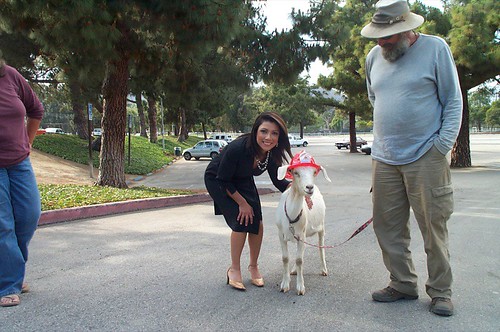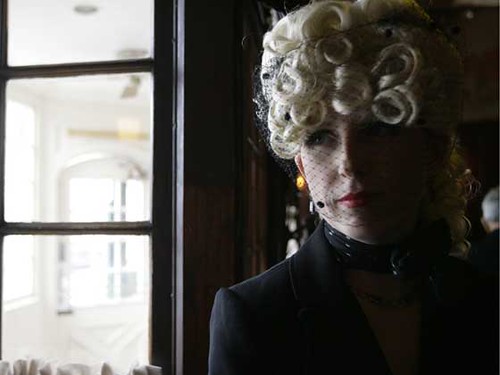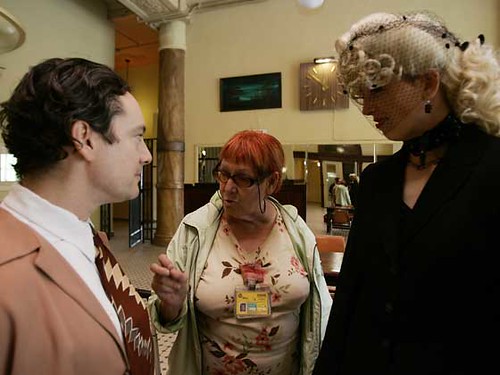…and beyond! The Crime Bus now sails under the Esotouric flag, offering bus adventures into the secret heart of Los Angeles. Kindly visit our new site for the scoop on exciting new tours like James Ellroy Digs LA, Raymond Chandler’s Los Angeles, John Fante’s Dreams of Bunker Hill, Reyner Banham Loves Los Angeles, Hotel Horrors and Main Street Vice.
Category: Kim Cooper
Los Angeles demands goats for fire safety
Frankie the Fire Goat is on Myspace… be his friend?
Please click here to sign our petition demanding fire-fighting goats to protect our city! Please note, protest signatures will not appear or be counted. (Below, Channel 7’s Elsa Ramon with Frankie the Fire Goat)

To: City of LA/ L.A. Department of Recreation and Parks
The citizens of Los Angeles are deeply concerned after serious wildfires in the Griffith Park and Hollywood Hills have destroyed vast swaths of urban wilderness and killed or displaced thousands of animals during their breeding season.
These fires feed upon unchecked dry undergrowth, and endanger lives, homes, historic monuments and our enjoyment of the city. It will take decades before Griffith Park is restored to its pre-fire condition.
We the undersigned demand that the City of Los Angeles and the L.A. Department of Recreation and Parks respond to this continued threat by bringing in shepherds with herds of goats to graze on the dry hills, a plan previously implemented with great success by UC Berkeley in the aftermath of that community’s devastating 1991 fire.
Goats are economical, ecological fire-fighting machines that produce fertilizer as they clear hills and canyons of weeds, poison oak and dry chaparral. Additionally, the animals are charming, newsworthy ambassadors for fire safety, a subject that needs to be more widely discussed.
We want to save our parks and mountains. We want goats!
Sincerely,
Please click here to sign our petition demanding fire-fighting goats to protect our city! Please note, protest signatures will not appear or be counted.
AP feature: Crime tours take passengers through LA’s criminal past
Above: Kelly Kuvo, the Blonde Dahlia
LOS ANGELES — A dismembered wannabe starlet. A girl buried under her family’s home. A rattlesnake used as a weapon.
The scenes of those crimes are stops on a series of Southern California bus tours that eschew the usual stars’ homes and theme parks to offer passengers a peak at the region’s dark side.
"They’re aimed at the history geek sort of people," said Kelly Kuvo, who wears a black veil and other vintage accouterments during the trips she leads for tour company Esotouric.
The company’s "crime bus" tours plumb the grisly, blood-soaked pasts of now quiet Southern California neighborhoods and nondescript strip malls.
Similar trips elsewhere take passengers deep into cities’ gory pasts, including Washington’s "Bad Olde Days" chronicling crime in the nation’s capital and "Sinister London" that follows the steps of Jack the Ripper.
"When people die in a place, it does change that place forever," said Esotouric guide and co-founder Kim Cooper. "Just because the people wandering around the neighborhood may not be aware of it, it doesn’t mean it’s not a good idea for people who are interested in history to revive those memories."
John G. Cawelti, who writes about the seductiveness of violent crime tales in his book "Mystery, Violence, and Popular Culture," said the tours play into people’s fears of death and catastrophe.
"We live in an age where the worst kinds of things can happen to anybody," Cawelti said. "Walk down the street and something blows up and all of a sudden you lost your life or lost a leg. The fact that somebody else went through this becomes a surrogate – a magical way of charming away the fear of the possibility."
Esotouric’s most popular tour explores 1947 Los Angeles by zeroing in on the murder of Elizabeth Short – a.k.a. "Black Dahlia" – who came to Hollywood in search of fame but wound up the victim of an infamous unsolved murder.
One stop is a ground-floor storefront on a desolate downtown street that now boasts a sign reading, "Club Galaxy – 100 Beautiful Girls."
In 1947, when it was a bistro called "The Crown Grill," it was the last place Short was seen before her dismembered body was discovered miles away in a south Los Angeles neighborhood.
"She was friendly with the bartenders and with some of the waitresses, so people recognized her and remembered her," Cooper said. "The problem of course is that everybody at the Crown Grill immediately became suspects."
Passengers are also introduced to lesser known crimes from the same year, such as the attempted carjacking in Hollywood of an 18-year-old movie theater cashier named Ginevra Knight, who shot her assailant dead.
"It’s the criminal history of 1947 L.A. and how women felt going out at night in the hysteria of an unsolved murder," Cooper said.
The "Blood and Dumplings" tour through San Gabriel Valley suburbs, meanwhile, passes the home where a young bride-to-be was buried in 1969 by her uncle after he shot her to death in a jealous rage at the end of their affair.
It also cruises by an intersection where a man named Raymond James bought a rattlesnake he let bite his wife in 1935 so he could cash in on her insurance policy. When she didn’t die, he had an accomplice finish the job by drowning her in their fish pond.
Esotouric grew out of a Web log Cooper started in 2005, when she set out to retell a true-crime tale from each day of 1947. She and her collaborators soon started offering tours of those scenes and the sites of other crimes.
A tour that revisits the life and literature of Raymond Chandler, whose fictional characters inhabit the region’s underworld, was added to the menu of crime junkets when the company was started earlier this year.
Tour participant Bob Nickum, 59, a school district business manager, said seeing the sites of past crimes made him look at familiar places in a new way.
"It’s just very interesting to drive around the area and to see things I may have passed by many times and maybe not known what happened there," said Nickum, who, like most passengers, lives in Southern California.
"It makes things a little more interesting – vivid – to know about something that intense that took place in a calm, peaceful neighborhood," he said.
Nathan Marsak, chess shark Heather and Kelly at the Hotel Barclay
How Men Turn To Crime
May 4, 1927
Los Angeles
Facing a sixty day sentence for bootlegging before Municipal Judge Tunney, Euell Thomasson appealed to the court’s mercy in light of his rather unusual personal history.
He had, Thomasson swore, been gainfully employed by a creamery company which sent a troupe of live, chained bears around town in its wagons as an advertising gimmick. Naturally, being bears, they were inclined to get cranky on the road, and one day one lunged at Thomasson and took a healthy bite out of his thumb.
This left him unable to work, and his employers refused to pay any compensation. So he began selling alcohol, a trade which apparently calls for but one working thumb.
It is a judge’s job to weigh the facts and mitigating circumstances in cases complex and peculiar. Judge Tunney determined the value of a bear-bitten thumb to be ten days, and sentenced the prisoner to fifty days in stir.
With Time Off For Being So Enterprising
May 3, 1927
Pomona
Some call it extortion; we call it a rather clever short con. C.L. Jackson and R.W. Hedgreth, both 48 and old enough to know better, approached service station operators Harold K. Hemmingway and Norman Bliss in the guise of being Prohibition officers, and asked where ’round here one could wet one’s whistle. After being informed of the details, Jackson and Hedgreth threatened to alert the real Prohibition men of the illegal info being spread, and demanded a pair of tires, gasoline and $25 cash to keep quiet. But Hemmingway noted the serial numbers on the bills and called the law, and the crooks were soon nabbed.
Justice U.E. White must not have thought much of the victims in the case, for he sentenced the men to six months in County Jail, which he promptly suspended for good behavior.
Meanwhile, in Reno, Nevada’s first short residency divorce was granted to Sophia M. Ross of New York, who braved the desert winds and cultural drought for three months so she could be freed of her Albert, who ate mashed potatoes with his hands.
The Street Crime of the Day
May 1, 1927
Los Angeles
In the Times today, a round-up of street crime incidents calculated to terrorize city residents, or at least discourage freelance musicians, good Samaritans and lingering outside a lady’s home in an open car–sheesh, buddy, get a room.
Clarinetist Antonio Cili thought he was being hired to play a gig when three gentlemen picked him up at Sixth and Broadway, drove to Fourth and Pecan, tossed him from the car, beat him silly and stole his instrument and $20.
Jennie Emerson of 2611 Vallejo Street was nearly run down in the street while crossing at Daly and Manitou in Lincoln Heights, and while recovering her wits confronted by the armed driver and his pal, who threatened to kill her before stealing her purse.
A bandit robbed J. Maganuma of $40 cash and a serving of chop suey at his restaurant at 4911 South Broadway. It was not reported if Mr. Maganuma spat in the food, but we certainly hope so.
A. Eisner was carjacked at First and New Hampshire, forced to drive to Sixth and Lucas and relieved of his $100 stick pin, $40 watch and $8 cash. Maybe it’s Eisner’s home address of 5579 Santa Monica Boulevard or the fancy stick pin that gives this brief tale the whiff of rough trade, or possibly we just have dirty minds.
Joseph Michael, while strolling by a doorway near First and Main was lassoed by a couple of rope-wielding miscreants who strangled Michael into unconsciousness and stole $35, this just two blocks from Central Police HQ.
Kindly Arthur Roper was driving along (now defunct) California Street near Figueroa when he spied a fashionably garbed young lady in apparent distress in the middle of the road. He stopped to lend aid and her friend hopped onto Roper’s running board with a revolver, which was clapped to Roper’s chest while the gal riffled his pockets of $53 cash.
And then there was Jacob L. Johannes of 228 South Rodeo Drive, who was sitting in a car with Miss Marie Boucher outside her home at 5806 Carlton Way when a fiend with a revolver relieved the lady of a $1000 fur coat, $75 watch and $50 bar pin. Johannes lost $6 cash. Buddy, you can’t afford a room… or Miss Boucher.
Now be careful out there!
May 5 is a Black Dahlia Day
This Cinco de Mayo is just oozing with the spirit of the Black Dahlia. Not only will we be running our Real Black Dahlia Crime Bus tour that afternoon, but our pal Joe D’Augustine has his neo-noir, Dahlia-drenched flick One Night With You screening at the Los Feliz 3 as part of the 2007 Silverlake Film Festival. Unfortunately, these events overlap, but the film screens again at 7:30pm on 5/9, so if you’re clever, you can attend both and make it a Black Dahlia week. More info is below, and for tickets, click here.
ONE NIGHT WITH YOU USA 2006
DIRECTOR/WRITER: JOE D’AUGUSTINE
In this hip, offbeat flick, shot mainly in and around Echo Park, Jake Tarlow (Mark Boone Junior) is a down on his luck hustler who is trying to make enough dough to pay off his bookie. All he has to do is locate the reclusive and eccentric author Hunter Burnell, played with equal parts style, insanity and humor by Michael Parks, and bring him in to sign a deal for one of his books. Jake enlists the help of his friend Eddie (Jake La Botz,), who is completely obsessed with the Black Dahlia, to track him down. Then comes the problem of keeping him under control long enough to get him to the meeting, which quickly proves impossible. What follows is a hilarious wild goose chase through the streets of Los Angeles, with Jake and Eddie following a false trail to Hunter, who is busy having the time of his life with hookers, cocaine and bar fights. This film, a combination of film noir and physical comedy, is a fun romp through some of the Eastside’s hot spots with a fantastic soundtrack featuring contributions from two Italian film music masters, Alessandro Alessandroni and Antonello Vannucchi.
Wither Sim Cross?
April 27, 1927
Los Angeles
Sim Cross is alive, ALIVE! The Los Angeles man, resident of 4195 Third Avenue, was believed a suicide by pals after a full suit of clothes but the underpants were found on the beach at Redondo on April 19. Mugs were raised, his good and bad points debated, and perhaps the pals even parcelled out his nicest ties among them. But on the 21st there came a telegram, signed Sim and sent from San Francisco, announcing that reports of his demise were not to be believed.
In time, he returned home, bearing a singularly peculiar tale. The last thing he remembered, see, he was fighting a riptide. And then, inky darkness. He came to 48 hours later in an SF hotel room, with bruised feet and no idea how he got there. In the room, clothes and a suitcase he’d never seen before. He dressed, and stepped into the street, where two men accosted him. It was thanks to them, they said, that Sim was in this spot. And now all they needed was for him to take someone’s place in a hospital for a few more days and…
Here Sim drew the curtain over one of the most perfect descriptions of cliche detective’s peril as we’ve ever read. He claims that he simply demured and came home.
Was it all fantasy? Or did once there dwell strangely maleable hoodlums, who would conk a guy while he swam and spirit him away to play a part in a bandage opera, then let him go when he said he wasn’t in the mood? We’ll never know, for after this one extraordinary incident, Sim Cross vanished from the record, but never from our hearts.
Twenty Cent’s The Charm
A Perfect Hostess
April 24, 1927
Los Angeles
Consider if you will the American bootlegger, that rat among rats, profiteer and fiend, feeder of poison to nice kids who hardly deserve to go blind or mad, lose their teeth in a brawl or crack their skulls in a crash. In time, some will become respectable, send their sons to Harvard or even the White House, but not now. We all know what bootleggers are like… don’t we?
Maybe not. Consider Hattie Mitchell, address unprinted, who appeared in Municipal Judge Turney’s courtroom to face charges of dispensing fire water to quite an array of gentlemen. The twist? She served her liquor in her bedroom, while laid up with a broken leg. The whiskey bottles stayed under the covers getting warm when they weren’t being poured, and the government’s man never saw money change hands, but all the same–a speakeasy, right there in her sickroom, not to mention the impropriety of a half-clothed woman serving liquor to men who weren’t family!
It was all too much for Judge Turney to take, and so the (formerly?) supine lady was sentenced to six months in jail and a fine of $500. But here at 1947project, we salute a gal with the gumption to ensure a steady stream of visitors to her sickbed, and are already planning our own future recovery, which will include daily specials, jukebox music and popcorn shrimp served promptly at 4pm.





